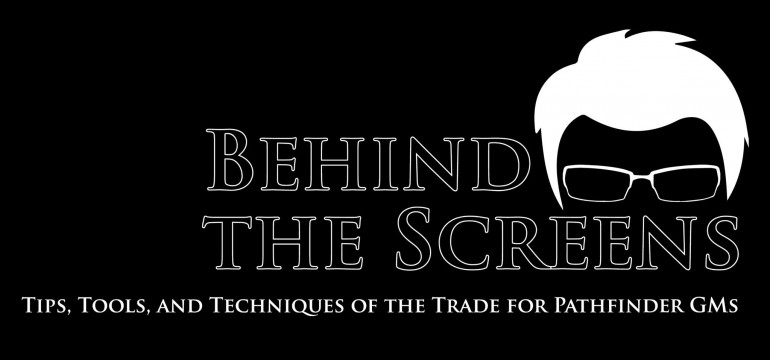Sometimes, plans need to change. For example, in case you missed it, this is Ryan, filling in for Anthony. I offered to take his place Behind The Screens today so he could fill in for James on this week’s Code/Switch. James was busy, Anthony had a topic he wanted to talk that fit James’ blog better than his own but couldn’t write two articles this week. It took a little shifting and changes from the norm, but everything worked out for everyone. That’s a fact and a metaphor.
Personal limits and keeping everyone comfortable at the game table has been a topic of late both on the site and in the industry, with Horror Adventures in particular discussing how to run a campaign of terror without terrorizing your players. Some of the advice includes surveying your players and presenting trigger warnings, but as illustrated in our review of that book, when Alex confessed having acrophobia and feeling insulted that it is considered a madness. Knowing your own limits takes greater self-awareness than you might realize. Likewise, before a GM can list the trigger warnings in their adventure, they need an idea of what might trigger their players. Going back to Alex, I was surprised to hear about his fear of heights. It’s not unheard of, I just wasn’t aware of it. If my adventure portrayed an acrophobic NPC in a stigmatic way, and Alex was in my group and I wasn’t yet aware of his phobia, I probably wouldn’t think to include that NPC in my trigger warnings.
Let’s say that despite your best efforts, you’ve introduced an element that makes a player uncomfortable enough that they’d prefer it not be included in your campaign. Once this happens, you as the GM and the player in question have a contrast of interests to work out. It’s fair to not want planning to go to waste, and to be disappointed by the lost potential of an idea that excited you. That doesn’t give you the right to dismiss the player’s objection, of course. Surely part of why you were excited was to see your players interact with your idea, and that did not include ruining anyone’s night every session. But you are right to be bummed.
There are three tactics to take in this situation: Wait and See, Retcon Details, and Abandon Hook. It’s advised that you at least invite the offended player into the decision making process as to what tactic you wish to employ.
Wait and See
This requires the least compromise on your part and the most compromise on the part of the player. You ask that the player trust that you understand their objection and are taking it seriously, and that you will organically address the objection in-game. If, for example, you are running an NPC who is vocally prejudice in a way that the player relates to and that ruins the escapism they’re seeking, you can confide in them that they will have a chance to take out their frustration on the offending NPC in a few sessions.
Trust is the operative word in using this tactic, and it’s not hard to find examples of that trust feeling taken for granted. For over a year now, Marvel’s been telling Captain America fans (and Marvel fans in general, given how central the character is to their universe) to see where Nick Spencer is going with his Hydra Cap storyline. However, they escalated the storyline beyond the tolerance level of a good portion of the objecting fans, and the negative reaction got to the point that Marvel doubled down on the wait and see tactic by giving out explicit details.
Only consider this tactic if you as the GM feel particularly strong about the choice you’ve made, and you believe you can adequately mitigate your player’s discomfort in the long run and every step along the way. Otherwise, find a way to compromise, because this tactic is less about compromise and more about choosing the hill you’d die on.
Retcon Details
Let’s be honest, no one remembers every detail of one session by the next (or at any two points of the same session, really). Even if every player and the GM in a group of five makes it to every session of a campaign, which details each person remembers means everyone has a unique version of the events that transpire. If what your player specifically objects to isn’t a load-bearing detail, it will not be missed. And if someone does remember it and questions it, put a lampshade on it.
A longform campaign shares a lot in common with book series, shared comic universes, and professional wrestling. Anyone whose read Wolverine’s first appearance knows he was originally portrayed as the most polite Canadian stereotype you can imagine. If you’re familiar with Wolverine as the best there is at what he does, and what he does isn’t very nice, you’ll scoff at dialogue like “I’ll just keep moving, if you please, because moving is the thing I do best” coming from his mouth. Batman killed the villain at the end of his first appearance. Kramer on Seinfeld had plots involving both baths and showers through the series even though he said that a bath is “disgusting. I’m sitting there in a tepid pool of my own filth” in one episode but “I take baths” in answer to Elaine asking “Do you go in the shower?”
It would be nice if these contradictions didn’t happen, sure, but then we wouldn’t have Batman and Wolverine as we know them. If people can change everything about how Wolverine is written just because, then the most continuity-obsessed player can accept that a detail is a bit different for the sake of everyone’s enjoyment at the table.
Abandon Hook
When all else fails, leave it aside. Have it resolved off screen or have the consequences turn out to be less dire than anticipated. A campaign is the story of the PC heroes responding to GM threats. Any threat can fluctuate in importance. I’m not advocating for the illusion of choice (I believe the only way player have weight is if they actually matter), but the world is in the GM’s control.
The perfect example of this is when WWE “killed off” Vince McMahon, the most important NPC on the show. One Raw ended with his limo exploding. The next live Raw opened with him addressing the crowd. In between, WWE wrestler Eddie Guerrero died in real life. They went the sensitive route (the WWE went the sensitive route!) and cancelled the murder mystery plotline they had. If the WWE can be sensitive to people’s feelings and change their million dollar plans, a GM can find a way to do the same for their group of friends.






